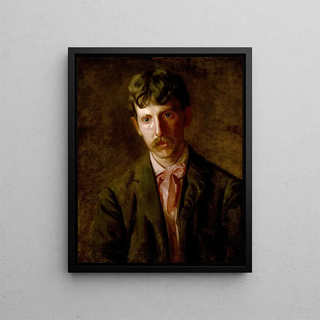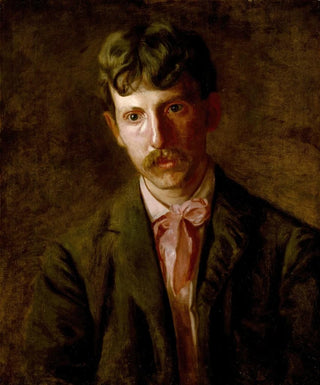Art print | The pianist Stanley Addicks - Thomas Eakins


View from behind

Frame (optional)
Art print of The Pianist Stanley Addicks by Thomas Eakins – Captivating Introduction
In the fascinating universe of art, some works stand out for their ability to capture moments of life, freeze emotions, and evoke personal stories. "The Pianist Stanley Addicks," an iconic piece by Thomas Eakins, perfectly embodies this tradition. Through this painting, Eakins does not merely depict a musician; he invites us to delve into the intimacy of a moment, to feel the passion emanating from the music, and to discover the depth of the human soul. This painting, a true reflection of its era, is an invitation to explore the subtleties of artistic performance and the relationship between the artist and their art.
Style and uniqueness of the work
Thomas Eakins's style is characterized by a realistic approach that transcends simple representation. In "The Pianist Stanley Addicks," Eakins employs a palette of rich, nuanced colors, creating a striking contrast between light and shadow. Every brushstroke seems charged with intention, with emotion. Addicks's focused face, his delicate hands on the piano keys, testify to technical mastery and undeniable passion. Eakins manages to capture not only the physical appearance of his subject but also the very essence of their performance. This ability to seize the soul of a musician, to make the music palpable through the image, makes this work an exceptional piece. The composition, carefully thought out, guides the viewer's gaze, inviting them to immerse themselves in this sound universe and to feel the vibrations of the melody.
The artist and his influence
Thomas Eakins, a major figure in 19th-century American art, is often recognized for his commitment to realism and his exploration of themes related to the human condition. His training in Paris and his interaction with the great European masters allowed him to develop a unique style, combining academic rigor with personal sensitivity. Eakins is not merely an observer; he is a storyteller, a witness to human passions. His influence extends well beyond his era, inspiring many artists to explore the relationship between art and life. By painting subjects drawn from

Matte finish

View from behind

Frame (optional)
Art print of The Pianist Stanley Addicks by Thomas Eakins – Captivating Introduction
In the fascinating universe of art, some works stand out for their ability to capture moments of life, freeze emotions, and evoke personal stories. "The Pianist Stanley Addicks," an iconic piece by Thomas Eakins, perfectly embodies this tradition. Through this painting, Eakins does not merely depict a musician; he invites us to delve into the intimacy of a moment, to feel the passion emanating from the music, and to discover the depth of the human soul. This painting, a true reflection of its era, is an invitation to explore the subtleties of artistic performance and the relationship between the artist and their art.
Style and uniqueness of the work
Thomas Eakins's style is characterized by a realistic approach that transcends simple representation. In "The Pianist Stanley Addicks," Eakins employs a palette of rich, nuanced colors, creating a striking contrast between light and shadow. Every brushstroke seems charged with intention, with emotion. Addicks's focused face, his delicate hands on the piano keys, testify to technical mastery and undeniable passion. Eakins manages to capture not only the physical appearance of his subject but also the very essence of their performance. This ability to seize the soul of a musician, to make the music palpable through the image, makes this work an exceptional piece. The composition, carefully thought out, guides the viewer's gaze, inviting them to immerse themselves in this sound universe and to feel the vibrations of the melody.
The artist and his influence
Thomas Eakins, a major figure in 19th-century American art, is often recognized for his commitment to realism and his exploration of themes related to the human condition. His training in Paris and his interaction with the great European masters allowed him to develop a unique style, combining academic rigor with personal sensitivity. Eakins is not merely an observer; he is a storyteller, a witness to human passions. His influence extends well beyond his era, inspiring many artists to explore the relationship between art and life. By painting subjects drawn from






